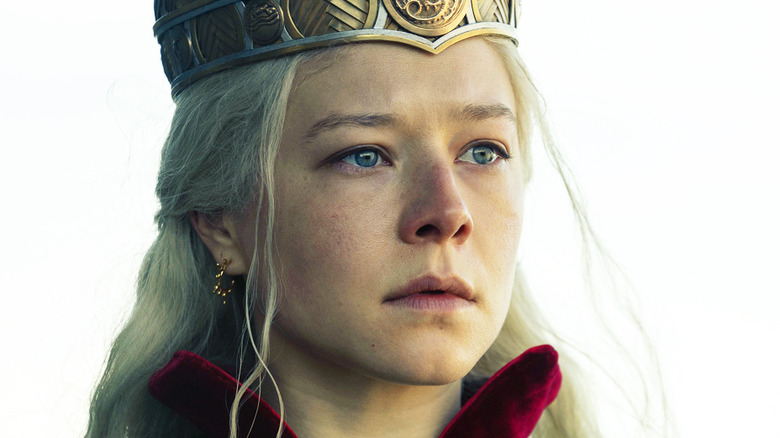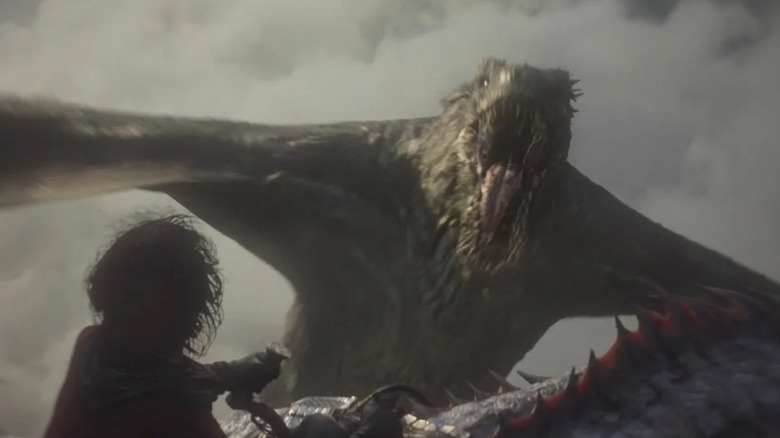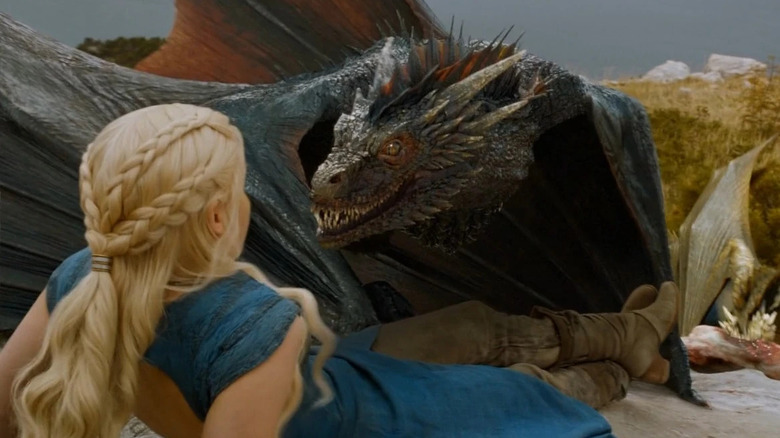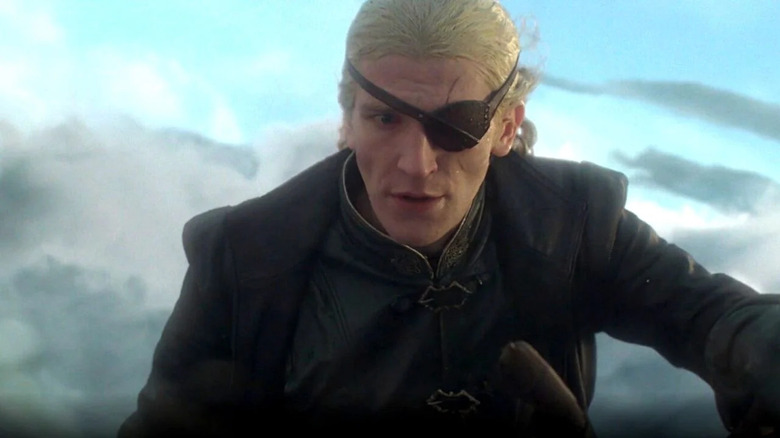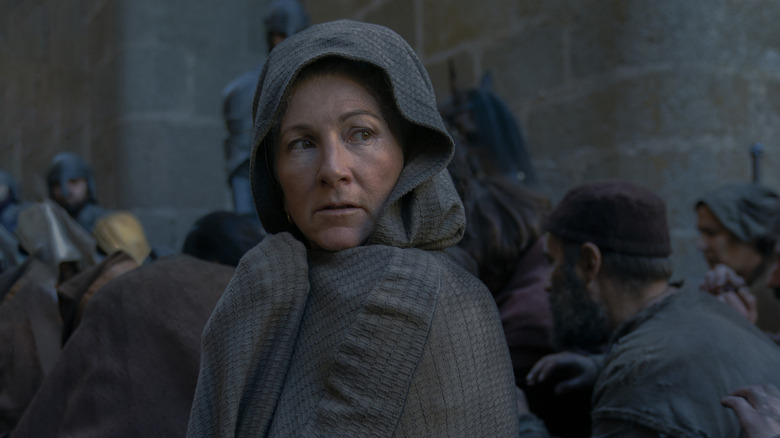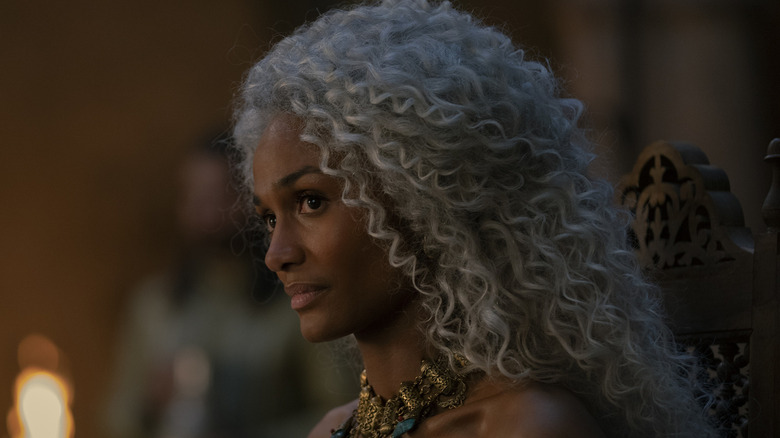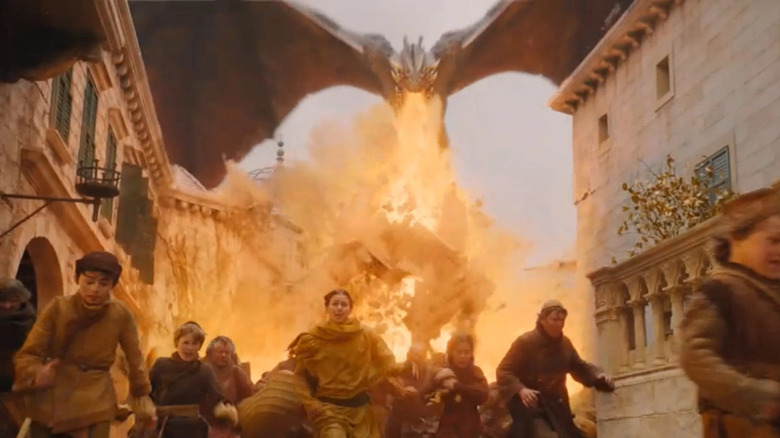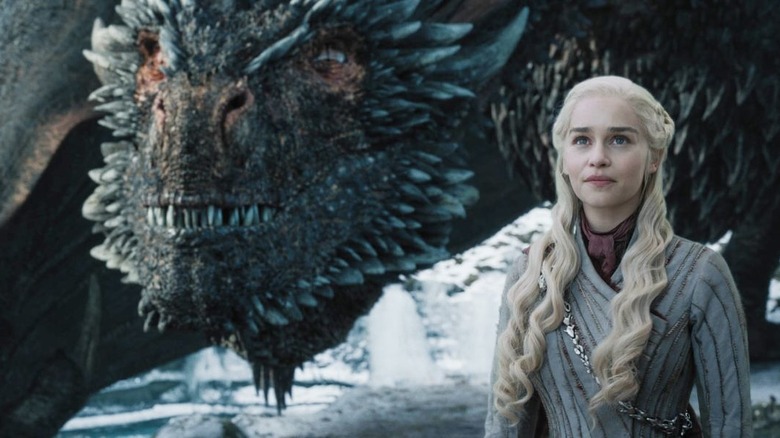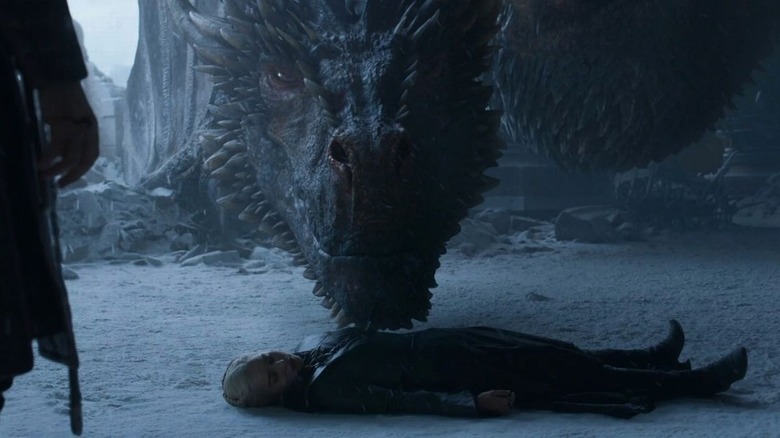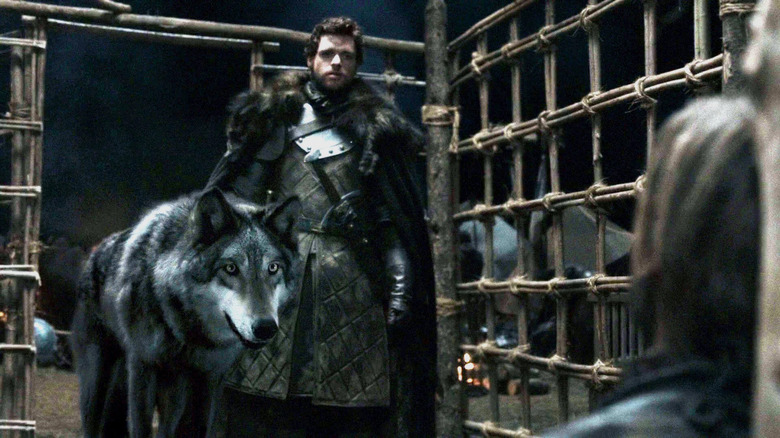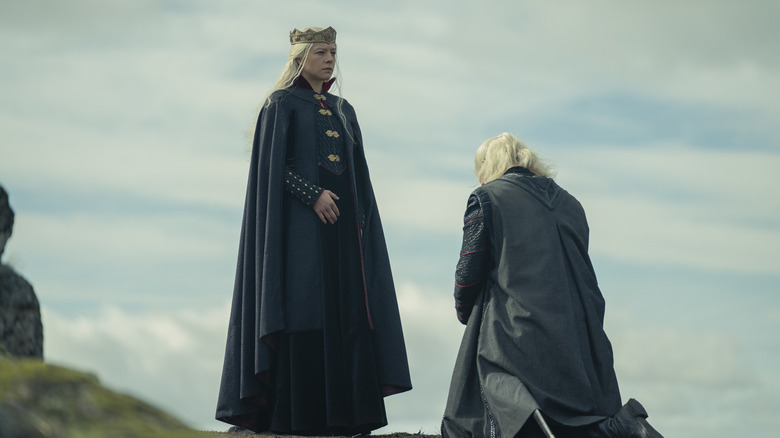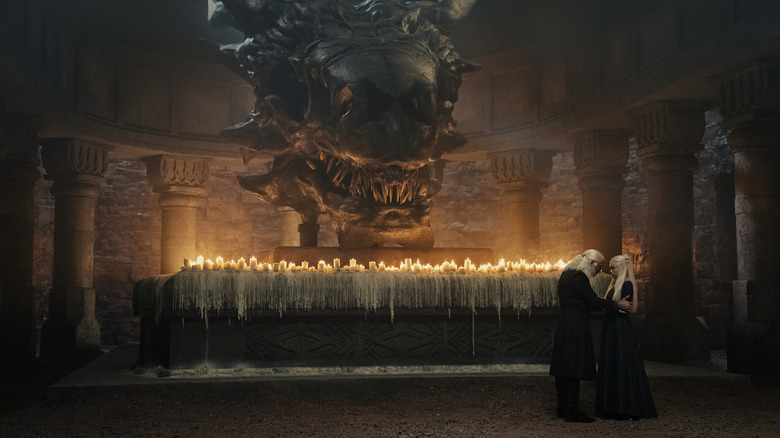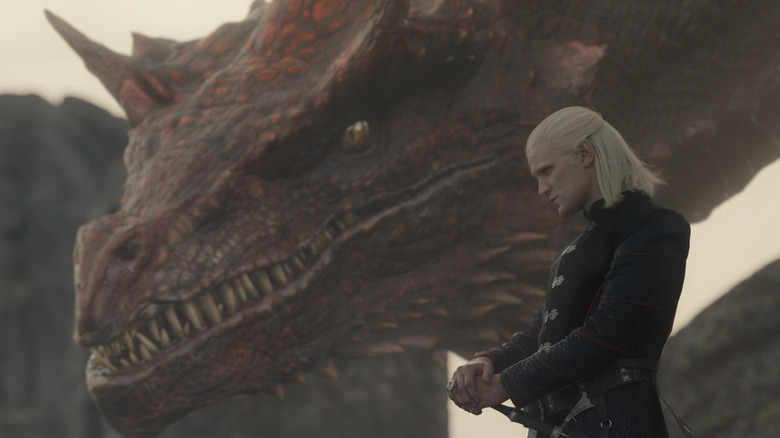Ways House Of The Dragon Season 1 Changed What We Know About Dragons On Game Of Thrones
Season 1 of "House Of The Dragon" gives fans plenty of juicy new political scandals, dastardly alliances, and dragon action to sink their teeth into. This prequel series, set nearly 200 years before "Game of Thrones," finds House Targaryen at the height of their power. But even at this apex, family turns on family, leading to the civil war known as the Dance of the Dragons.
At the heart of the conflict is King Viserys I (Paddy Considine), his daughter Princess Rhaenyra (Milly Alcock, Emma D'Arcy), roguish Prince Daemon (Matt Smith), and the scheming Hightowers. The latter group consists of the King's Hand, Otto (Rhys Ifans), and Viserys' second wife, Queen Alicent (Emily Carey, Olivia Cooke). As the family begins to implode throughout Season 1, viewers learn more about what makes the titular house tick — particularly when it comes to their iconic dragons.
Fans might have thought they knew everything about the scaled beasts, but "House of the Dragon" reveals this is false. We learn so much more about dragons in Season 1 of the prequel series, it throws absolutely everything about them into bright new light. Dragons are revealed as jealous, noble, magical, strange, caring, and, of course, massively powerful. We're here to take a look at all the ways "House of the Dragon" changes what we know about dragons from "Game of Thrones."
The Targaryens can't completely control their dragons
Tragedy thrice strikes Rhaenyra Targaryen in the Season 1 finale, "The Black Queen." Rhaenys (Eve Best) arrives at Dragonstone after escaping King's Landing on her dragon, Meleys, to deliver devastating news: King Viserys is dead, and the Greens have seized the Iron Throne. News of her father's demise triggers a premature labor, and Rhaenyra's daughter, Visenya, is stillborn. The grieving queen then loses another child when her son, Lucerys (Elliot Grihault), is killed at Storm's End.
Lucerys' death in the show differs from the account in "Fire & Blood." The book, written from the perspective of the fictional Archmaester Gyldayn, states that Aemond intends to kill Lucerys and his dragon with Vhagar; however, the season finale portrays Lucerys' death as an accident, with both princes losing control of their dragons. A terrified Arrax attacks Vhagar against Lucerys' commands, causing Vhagar to take matters into her own hands — or jaws — making short work of the smaller dragon and his rider.
This echoes what Viserys tells Rhaenyra about the dragons in Episode 1, "The Heirs Of The Dragon:" The Targaryens' do not actually have full control of their dragons. There's no denying the bond between dragon and dragon rider — Arrax shares Lucerys' panic in "The Black Queen," while Caraxes, Daemon's dragon, shrieks in pain when Daemon is hit with an arrow in Episode 3, "Second Of His Name." But the Targaryens' can't truly control their dragons. As Daenerys Targaryen informs fans during "Game Of Thrones:" "A dragon is not a slave."
Fans have seen disobedient dragons before
This isn't actually the first time viewers have seen a dragon disobey its rider. In Season 4 of "Game Of Thrones," Daenerys (Emilia Clarke) struggles to maintain control over her growing dragons, particularly Drogon. Drogon actually snaps at Daenerys in Episode 1, "Two Swords," prompting Jorah Mormont (Iain Glen) to declare that the fire-breathing beasts can never truly be tamed. Later in the season, Daenerys discovers Drogon has killed a child, leading to her chaining her remaining dragons, Rhaegal and Viserion, in the Great Pyramid's catacombs, while Drogon flees Meereen.
Daenerys' dragon-related woes extend throughout Season 5. Rhaegal and Viserion grow wild in confinement, while Drogon remains AWOL for most of the season. It isn't until Episode 9, "The Dance of Dragons," that Daenerys reunites with Drogon, when the rebellious dragon rescues her from the Sons of the Harpy in Daznak's Pit. But even after their first flight together, Drogon continues to disobey Daenerys' commands to return to Meereen, causing Daenerys to wander into the Dothraki's clutches.
Not until Season 6 do viewers see the Targaryen queen finally master her dragons. How she does it remains unclear: Daenerys seemingly senses Drogon's presence in Episode 6, "Blood Of My Blood," and rides her dragon to embolden her new khalasar. After that, Daenerys and Drogon's bond is stronger than ever. She rides Drogon into battle numerous times throughout Seasons 7 and 8, more connected to him than ever before.
Ancient dragons are a handful
Vhagar is the oldest and largest of the Targaryen dragons. Originally ridden by Visenya Targaryen, one of Aegon the Conqueror's sister-wives, Vhagar played a vital role in the Targaryens' conquest of Westeros. Alongside Balerion, Aegon's dragon, and Meraxes, Rhaenys' mount, Vhagar brought fire and blood to the Seven Kingdoms a century before the events of "House of the Dragon." By the time Aemond claims Vhagar after Laena Velaryon's (Nanna Blondell) funeral in Episode 7, "Driftmark," the dragon is an ancient, war-hardened behemoth, and certainly not to be taken lightly.
Aemond uses Vhagar to torment his nephew, but the Targaryen prince forgets that Vhagar is a savvy beast with a mind of her own. When Arrax attacks, Vhagar goes into battle mode. Not only does Arrax's fear-fueled assault provoke Vhagar's wrath, Aemond forgets to use High Valyrian commands, instead speaking in the Common Tongue.
It's possible that Aemond's bond with his dragon is weaker than his Targaryen brethren's: Aemond claims Vhagar later in life, rather than bonding with the dragon from birth like Aegon (Tom Glynn-Carney) and the Velaryon boys. He's only been the dragon's rider for roughly six years by the time he faces Lucerys and Arrax in the skies. No matter what, the results are tragic.
Not all riders are created equal
Comparing Aemond's disastrous flight on Vhagar to Rhaenys' escape from King's Landing on Meleys makes it clear that the elder Targaryen is a far more capable rider. When Rhaenys and Meleys burst out of the Dragonpit during Aegon's coronation, Rhaenys uses Meleys to send a powerful message to the Greens. The dragon issues a deafening roar, a cold stare, and a sharp turn into the sky.
Rhaenys' bond with Meleys appears to be far stronger than the ones mustered by the younger Targaryens. The Red Queen (as Meleys is called, for her red scales), was claimed by Rhaenys in 87 AC, three years after the death of Meleys' first rider (and Daemon and Viserys' mother), Alyssa Targaryen. Episode 9, "The Green Council," takes place during 130 AC. By this point, Rhaenys has been bonded to her dragon for 43 years — far longer than Aemond and Vhagar.
Time and experience give Rhaenys an advantage when it comes to riding dragons. Rhaenys also displays maturity and emotional control that far surpasses her adolescent cousins. Not to mention, Meleys isn't a veteran of war like Vhagar; the Red Queen has spent most of her life in the Dragonpit and at Driftmark, the ancestral seat of Rhaenys' husband, Corlys Velaryon (Steve Toussaint).
Dragons feel their riders' emotions
Season 1's finale gives fans a deeper glimpse into the psychic bond between the Targaryens and their dragons. Rhaenyra's birth scene is interwoven with snatches of Syrax screaming in pain. The she-dragon feels her rider's labor keenly, through they're far apart. This connection mirrors the one between Daemon and Caraxes in "Second of His Name," as well as the bonds present in the books. In "A Dance With Dragons," the fifth book in the series, Daenerys feels Drogon's pain when the dragon is attacked in Daznak's Pit. Both of them simultaneously scream in agony.
"House of the Dragon" doesn't just retain this element of dragon lore from the original source material — it might deepen it. Vhagar's bond with Laena Velaryon causes the dragon to hesitate when a dying Laena asks her to give her a fiery dragon rider's death in Episode 6, "The Princess and the Queen." In "The Black Queen," Lucerys tries to calm Arrax with Valyrian commands before fleeing Storm's End, but their shared fear causes Arrax to lash out at Vhagar against his rider's wishes.
This also corresponds with another nugget of dragon lore from the books. While riding Drogon in the Dothraki Sea, Daenerys notes that the dragon, unlike her horse, veers towards the whip when she tries to steer him. This is because a dragon's first instinct, when threatened, is to attack. Arrax's assault on Vhagar can thus be viewed as the dragon acting on instinct, with Vhagar responding in kind.
Does Daenerys lose control of Drogon in Season 8?
One of the most controversial moments from "Game of Thrones" Season 8 is Daenerys' fiery assault upon King's Landing. The Mother of Dragons' rapid descent into villainy polarized viewers, many of whom have criticized the act as incoherently motivated and rushed.
But what if "House of the Dragon" retcons that infamous scene? Perhaps Daenerys doesn't technically burn King's Landing — Drogon does. Fans now know that dragons can rebel, thanks to Lucerys' death in "The Black Queen." It's possible, then, that Drogon could have acted of his own accord while torching the city's streets, fueled by his emotional connection with Daenerys. Season 8 is a tragedy for the Targaryen queen: Jorah dies in Episode 3, "The Long Night," before both her other dragon, Rhaegal, and best friend, Missandei (Nathalie Emmanuel), are killed in Episode 4, "The Last of the Starks." Drogon could be fueled by Daenerys' grief when he attacks King's Landing. Like Vhagar, the black dragon may ignore his rider's commands, unleashing fire and blood on the surrendered city against Daenerys' wishes.
Daenerys is a young dragon rider
Daenerys' bond with her dragons on "Game of Thrones" differs from the ones the Targaryens of "House of the Dragon" hold. Daenerys hatches Drogon, Rhaegal, and Viserion in a show of mystical power by walking into Khal Drogo's (Jason Momoa) funeral pyre. This act revives dragons after more than a century of extinction. But Daenerys is still a young dragon rider in Season 8. By the time she attacks King's Landing, she's only ridden Drogon into battle for roughly two years.
Daenerys might lose control of Drogon during "The Bells." Although the Targaryen queen never admits to this, it's logical that she wouldn't: Admitting her command of Drogon is still shaky undermines her authority, especially with her armies depleted from the Battle of Winterfell. After losing so much, Daenerys would not want to lose Drogon, her last living dragon-child, as well.
They're an efficient duo throughout "Game of Thrones," but Daenerys and Drogon are no Rhaenys and Meleys. Rhaenys has the advantage of knowledge, having been raised among her family at the height of House Targaryen's power. Meanwhile, Daenerys is raised in exile in Essos after the Targaryens are defeated in Robert's Rebellion, and has to figure out the basics by herself. Her struggles and incredible youth only come into full focus in light of what "House of the Dragon" brings to the canon.
Daenerys and Drogon could return
News of a sequel series to "Game Of Thrones" initially broke on The Hollywood Reporter. George R. R. Martin took to his blog to confirm it, and that Jon Snow (Kit Harington) will take center stage as protagonist. It goes without saying that a sequel to Season 8 of "Game of Thrones" would have to address its most controversial moments — including Daenerys' attack on King's Landing.
Fans have theorized since the finale aired in 2019 that Drogon flew Daenerys' body to Essos, so the Red Priests could resurrect her. The Mother of Dragons has a fervent following among R'hllor's devotees: In Season 5's "The High Sparrow," Tyrion Lannister (Peter Dinklage) witnesses a Red Priestess preaching in Daenerys' favor to the people in Volantis, while another Red Priestess named Kinvara (Ania Bukstein) shows up in Season 6 to proclaim Daenerys as the Lord of Light's chosen one.
Jon Snow is resurrected by Melisandre (Carice van Houten), another Red Priestess, in Season 6 of "Game Of Thrones." It would be poetic for Daenerys, the only other remaining Targaryen in the main series, to receive a R'hllor-powered revival of her own. Jon and Daenerys' arcs parallel each other throughout "Game of Thrones:" Both are exiled from Westeros at a young age before becoming leaders and monarchs in their own right.
The Targaryens' bond with their dragons is unique
It's easy to compare the psychic bond between dragon and dragon rider on "House of the Dragon" to the relationships the Stark children have with their direwolves on "Game Of Thrones." The direwolves are linked emotionally to the Starks: In the books, Robb's direwolf, Grey Wind, grows increasingly bloodthirsty with every battle the Young Wolf faces, and Rickon's wolf, Shaggydog, becomes feral alongside his owner.
The Starks don't seem to have any trouble controlling their direwolves, however, unlike the Targaryens and their unruly dragons. Robb uses Grey Wind to intimidate a captive Jaime Lannister (Nikolaj Coster-Waldau) in Season 2's "The North Remembers," evoking shades of Rhaenys and Meleys. The Starks and their direwolves clearly utilize different magic than the Targaryens and their Valyrian ancestors. Making this even more clear is the fact that Bran can psychically step into his direwolf Summer's mind, effectively becoming the direwolf.
In contrast, the dragonlords of Old Valyria used mystical means like ensorcelled horns to control their dragons. The Targaryens discontinued this practice after fleeing to Dragonstone, however, which might explain why their control of their mounts isn't always absolute. In the books, Euron Greyjoy possesses a Valyrian horn called Dragonbinder, which he plans to use to steal one of Daenerys' dragons.
The Targaryens might have the literal blood of the dragon
"House of the Dragon" Season 1 confirms another gory Easter egg of dragon lore: The Targaryens occasionally give birth to monstrously dragon-esque children. Prosthetic designer Barrie Gower posted a photo on Instagram confirming Rhaenyra's stillborn daughter had startlingly reptilian features, giving all-new meaning to the term "blood of the dragon."
Season 1 of "Game Of Thrones" includes a similar moment for Daenerys. The pregnant khaleesi beseeches Mirri Maz Duur (Mia Soteriou) to save Khal Drogo's life after the Dothraki leader falls ill from an infected wound. Mirri enacts a blood magic ritual to revive Drogo, which kills Daenerys' unborn son, Rhaego, and renders Drogo catatonic. Mirri tells Daenerys that Rhaego was born deformed with dragon scales — much like Rhaenyra's daughter on "House of the Dragon."
Little is known of Old Valyria's magic. Could the Freehold's descendants possess the literal blood of the dragon? We can't say for certain, but "House of the Dragon" makes such a strange prospect feel distinctly possible.
Viserys was right all along
King Viserys says humanity should never have availed itself of dragons' power in "The Heirs of the Dragon." Lucerys' death provides strong evidence for this viewpoint. Aemond misuses Vhagar, the medieval equivalent of a missile, deploying her in an act of childish bullying against Lucerys in vengeance for his lost eye. In doing so, Aemond triggers a brutal war that will undoubtedly decimate House Targaryen in upcoming seasons of "House of the Dragon."
The Dance of the Dragons is a tale of generational trauma and tragedy, and an exemplary account of how destructive dragons can be. Viserys is right to caution Rhaenyra in "The Heirs of the Dragon," as they stand next to the skull of Balerion the Black Dread, the mightiest dragon to grace Westerosi skies. Dragons are an exceptionally dangerous force in this universe. In the wrong hands — or, arguably, any hands — they are a weapon capable of destroying anything.
The dragons are as dangerous as the White Walkers
"A Song of Ice and Fire" chronicles two opposing forces: The White Walkers beyond the Wall, and the dragons hatched by Daenerys. They turn out to be equally destructive. "House of the Dragon" explores this by dissecting what it truly means to ride a dragon, from the sky-soaring highs to the burning lows. When it comes to dragon riding, if you're not on the level of Rhaenys and Meleys, it might be best to take out insurance.
Aemond and Lucerys' clash in the Season 1 finale highlights how inconsistent House Targaryen's control of their infamous beasts really is. Like most magic in the "Game of Thrones" universe, it's more luck than science. If Aemond — a Targaryen prince at the height of the Targaryens' power, with unlimited access to Valyrian records and dragon lore — can't keep his dragon in check, who could? This suggests that dragons are, for the most part, untamable. Such wild power is easily as dangerous as the much-vaunted Walkers. Dragons might not be driven by the same desire to destroy the world, but they're clearly just as capable.
